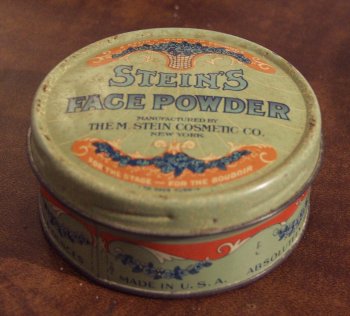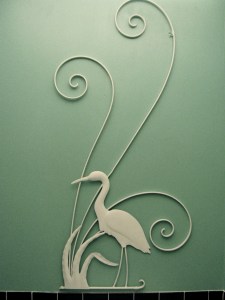One of the first things that people usually ask me when they find out I’m a dealer of vintage collectibles is, what do you collect? My answer is usually short and sweet – “Anything that is chipped or cracked!”
 My shelf in the kitchen holding my misfit kitchen collectibles –
My shelf in the kitchen holding my misfit kitchen collectibles –
lots of chips, cracks and rust spots hiding in there!
What I really mean when I say this is that my whole idea of collecting, and what I choose to keep for myself, has changed since I started to depend on selling collectibles as my income. The entire dynamic is different, but still, underneath my dealer persona, I am still a collector at heart.
 I have a bit of a bird collection going on in my kitchen!
I have a bit of a bird collection going on in my kitchen!
I suppose the biggest difference for me is that selling has become a way of collecting. Since collecting usually implies keeping, this may seem a little contradictory, but I can explain…
Before I became a dealer, I just bought what I liked, or what reminded me of my childhood, or my family. I never was the kind of collector that focuses on one niche, working to build a large number of items or a complete set of something (Well, except for my kitchen… for a while I had a mushroom themed kitchen, now I have a bit of a bird theme going on in there!). I was the kind of collector that picked up things I found at yard sales, estate sales and flea markets that spoke to me, that I thought were neat, or that I knew I could use or display easily.
 My non working vintage fan, my 1960s Ouija Board that I got for a quarter,
My non working vintage fan, my 1960s Ouija Board that I got for a quarter,
my Phrenology head I can’t seem to part with…
When I started selling, I took the same approach – and still do to this day. The only thing that is different is that now I have knowledge of what other people collect – so my buying reflects not only my own preferences, but the preferences of my potential customers. And instead of keeping what I find, I send it on to a new home where it will be valued and appreciated – which for me, is the ultimate in job satisfaction!
 My glued back together pixie figurine, and the girl and boy figurine
My glued back together pixie figurine, and the girl and boy figurine
that reminds me of me and my boyfriend… *blush*
That being said, there is still the little part of me that wants to keep things, and it works really hard at justifying those things that it has really fallen in love with. 95% of the time it goes something like this:
Vintage Geek Mitzi: “WOW This thing is awesome! I want to keep it.”
Practical Mitzi: “Ok, let’s take a look at this thing. How much could you sell it for? How much did you pay for it? What will you do with it? You realize half of your already small home is filled up with business stuff, right?
Vintage Geek Mitzi: “Yes, but it is too hard to ship, it has a chip and is missing a part, and look at that big scratch on the back… No one wants that. Besides, your grandma had one JUST LIKE it and you know you have that perfect spot to put it!
Practical Mitzi: “Rent is due on the 1st.”
Vintage Geek Mitzi: ” *sigh*… let’s get it listed.”
 My cracked vintage deer figurine with my boyfriend’s collection of green glass candle holders.
My cracked vintage deer figurine with my boyfriend’s collection of green glass candle holders.
Of course, 5% of the time Vintage Geek Mitzi wins. She finds just the right justification (usually valid, though sometimes it is a bit of a stretch) and keeps something, which is why I now call my house The Island of Misfit Collectibles. Most of the things I have are either too big to list, are extras from sets I’ve sold (for example, I have 7 glasses, I list a set of 6 and keep one), are flawed so they aren’t worth listing, or just aren’t valuable enough to be worth listing. And don’t forget the things that don’t sell after a year or two – which apparently weren’t worth listing to begin with, but I didn’t realize it – those I keep sometimes too.
 I found a big set of Lustro Ware that came with a cake carrier,
I found a big set of Lustro Ware that came with a cake carrier,
canister set, and this bread box – I sold everything but the bread box,
because I could actually use it!
Both Mitzi’s have a lot of fun though – there is just too much great stuff out there to get excited about to let the little internal battles get you down too much! And I’m excited to be writing for Inherited Values, where I can share what I’m in love with (that month, at least), and where I can use what I know to help collectors find the things they are in love with…
 My big eyed girl print that looks way too much like me…
My big eyed girl print that looks way too much like me…
I have two other blogs that I keep, one for my online selling business, Vintage Goodness, and one for my online vintage directory, The Vintage List, where I talk a lot about selling vintage online. I’m going to do my best to write posts that are very different from my usual posts on those blogs, and hopefully my fellow Vintage Geeks will enjoy them! 
 Museum of American History Poster – too hard to ship!
Museum of American History Poster – too hard to ship! 
 Ceramic canister set I had up online for a long time…
Ceramic canister set I had up online for a long time…
It never sold so now I have it. Too heavy probably, expensive to ship!


































































































